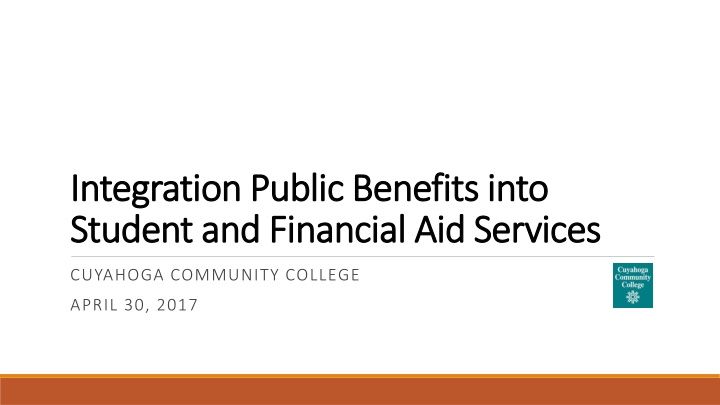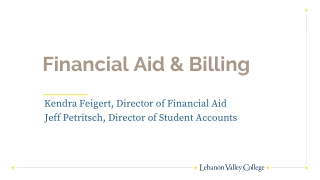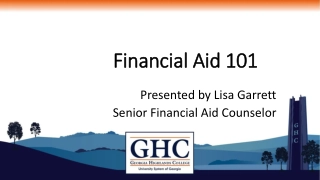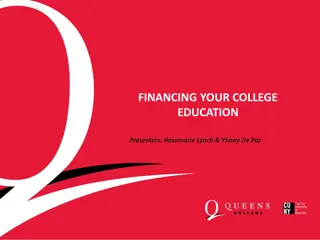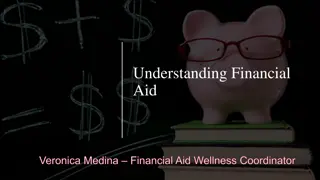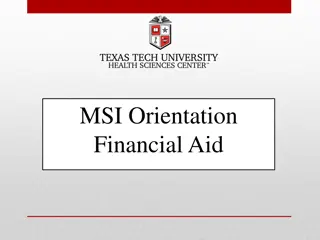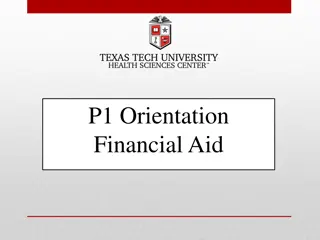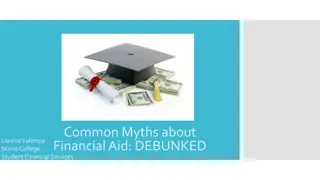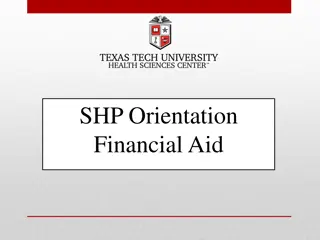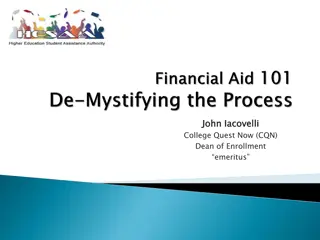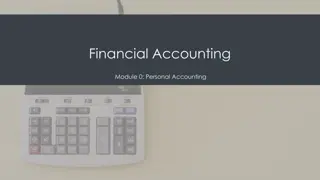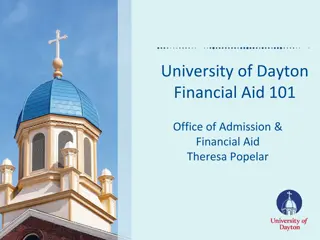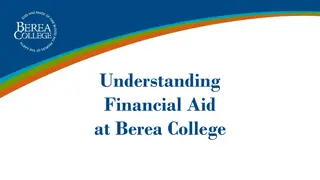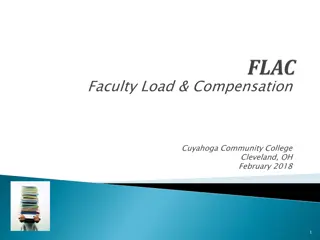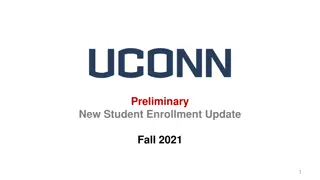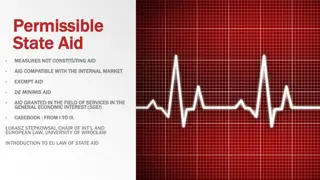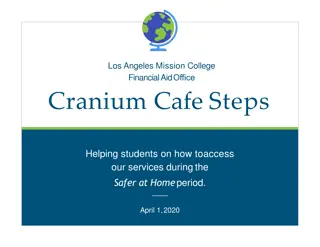Integrating Public Benefits into Student and Financial Aid Services at Cuyahoga Community College
This initiative at Cuyahoga Community College focuses on increasing access to public benefits for students, aiming to enhance student success and college completion. By providing information and assistance in applying for public benefits, students facing financial challenges can receive support to improve their educational outcomes.
Download Presentation

Please find below an Image/Link to download the presentation.
The content on the website is provided AS IS for your information and personal use only. It may not be sold, licensed, or shared on other websites without obtaining consent from the author.If you encounter any issues during the download, it is possible that the publisher has removed the file from their server.
You are allowed to download the files provided on this website for personal or commercial use, subject to the condition that they are used lawfully. All files are the property of their respective owners.
The content on the website is provided AS IS for your information and personal use only. It may not be sold, licensed, or shared on other websites without obtaining consent from the author.
E N D
Presentation Transcript
Integration Public Benefits into Integration Public Benefits into Student and Financial Aid Services Student and Financial Aid Services CUYAHOGA COMMUNITY COLLEGE APRIL 30, 2017
Cuyahoga Community College Cuyahoga Community College Advanced Technology Training Center Serving Northeast Ohio Hospitality Management Center at Public Square Lake County Eastern Campus Westshore Campus Metropolitan Campus Corporate College East Unified Technologies Center Geauga County Cuyahoga County Corporate College West Western Campus Summit County Lorain County Brunswick University Center Medina County BREAKING DOWN FINANCIAL BARRIERS TO COLLEGE COMPLETION
C Cu uy ya ah ho og ga a C Co ommun mmunit ity y C Co ol lle leg ge e Average age is 27 70 percent are in career/technicalprograms 50 percent place into Developmental math* 40 percent place into Developmental English* Over 60 percent receive financial aid 44,000 credit & 10,000 non-credit students 2017-2018 academic year
Cuyahoga Community College Cuyahoga Community College Cuyahoga Community College Mission To provide high quality, accessible and affordable educational opportunities and services - including university transfer, technical and lifelong learning programs - that promote individual development and improve the overall quality of life in a multicultural community.
Benefits Access for College Completion Benefits Access for College Completion Hypothesis: Providing students who are struggling to make ends meet with info about public benefits and assistance in applying for them will improve student success and college completion An initiative geared toward increasing access to public benefits for community college students Supported colleges developing sustainable models that build benefits access into the everyday activities across the college
Large Scale Problem Large Scale Problem Connect public benefit dollars provided by state and county funders Students drop out of college for financial reasons
Low Low- -Income students Income students 80% of Pell recipients receive the maximum Pell grant award More than 13,000 Pell grant recipients
Institutional Gap Analysis Institutional Gap Analysis Poverty Level of our Students Below poverty level 14,846 students (27.1%) 135% of the poverty level 17,355 students (31.7%)
Benefits Access for College Completion Benefits Access for College Completion December 2011 December 2011 - College invited to participate in grant initiative January 2012 January 2012 - Joined a group of colleges to share research and develop a plan January January August 2012 August 2012 - Designed the Project Go program August 2012 August 2012 Project Go program began under the Academic Affairs Division June 2013 June 2013 Implemented Peer Financial Coach positions in the financial aid office December 2013 December 2013 Hired financial aid managers June 2014 June 2014 Moved to and became fully integrated into Student Financial Aid & Scholarships services
Benefits Benefits Access/Project Access/Project Go! Integration into Integration into Financial Aid Services Financial Aid Services Go! Project Go! was fully integrated into student financial services after the grant ended. Benefits Coach Training, United Way 211 for all advisors Created Financial Aid Managers to manage Project Go program Created Peer Financial Coaches to assist students in applying for benefits Integrated Project Go services into Financial Education advising for students
Benefits Access/Project Go Benefits Access/Project Go Redefined financial aid beyond grants, loans and scholarships Integrated benefits access services (applying for SNAP, utility assistance, cash assistance, etc.) into financial aid application processes and financial education initiatives Target potentially eligible students by flagging financial aid records to encourage students to complete quick check for public benefits eligibility Public benefits assistance aligns with college s initiative to reduce student loan debt by obtaining other financial resources
Benefits Access Connections Benefits Access Connections Ohio Benefit Bank Food and Nutrition Programs Special Supplemental Nutrition Program for Women, Children, and Infants (WIC) Healthcare Assistance Programs Aged, Blind and Disabled (ABD) Medicaid Supplemental Nutrition Assistance Program (SNAP) Free and Reduced Priced Lunch Program (USDA) Healthy Start & Healthy Families Programs Medicare Premium Assistance Child and Family Health Services (CFHS) Bureau for Children with Medical Handicaps Medicare Low-Income Subsidy (LIS) Ohio s Best Rx (prescription drug discount) Tax and Student Aid Programs Free Application for Federal Student Financial Aid (FAFSA) Federal and State Tax Return Filing Earned Income Tax Credit (EITC) Other Programs Home Energy Assistance Program (HEAP) Ohio Works First Cash Assistance (OWF) Child Care Assistance (Title XX) Senior Community Service Employment Program (SCSEP) Golden Buckeye Program Voter Registration
Partner Agencies Partner Agencies Cuyahoga County Home Page Cuyahoga Jobs and Family Services Ohio Department of Job & Family Services (ODJFS) Ohio Department of Higher Education (ODHE) Ohio Benefit Bank (OBB) Cleveland Foodbank United Way 211 https://www.ohiohighered.org/sites/ohiohighered.org/files/OhioHigherEd_logo_jul2015.png The Ohio Benefit Bank
Benefits Access Target Grou Benefits Access Target Group p Target Population - Independent students EFC = 0 3000 (Received the Maximum Pell Grant Award) Answered No to SNAP on FAFSA Added poverty guidelines to the selection (2015-2016) Embed benefit screening into financial aid requirements by questionnaire for students in target group Connecting student to county for re-certification of benefits, based on college enrollment/attendance requirements
By the Numbers By the Numbers Potentially Eligible Students Response to Survey for Assistance Already Received Benefits Respondents Seeking Other Services Recertification Assistance 2014-2015 9,806 1,673 394 323 99 2015-2016 2,938 573 432 44 113 2016-2017 1,882 556 242 17 77
Comprehensive Approach Comprehensive Approach Build a comprehensive student aid system Can reduce indirect costs to education Prevent unnecessary student borrowing Can decrease student hunger and housing insecurity Can increase financial stability of adults and youth Can help students care for their families Can compliment existing funding streams
Why More Students Do Not Access Benefits Why More Students Do Not Access Benefits Lack of information, misinformation about eligibility Applying is often time consuming, frustrating Stigma and other social/cultural barriers Bureaucratic public policies Higher education and public benefits policies are not well aligned Many Tri-C student receive benefits
Program Outcomes Program Outcomes Modest increase in retention rates Refocus on financial education and student loan counseling Connection to default prevention and debt reduction initiatives Focus on understanding indirect costs of college Replication inquiries across the country, including the U.S. Department of Education
Program Evaluation Highlights Program Evaluation Highlights Benefits access services should be provided through a highly visible and well- known centralized hub with knowledgeable staff Colleges should implement models that require students to opt out of benefits services by connecting initial pre-screening steps to existing student support services Leadership at multiple levels and across departments needs to recognize benefits access services as an institution-wide priority and enact policies and practices necessary to support the institutionalization of benefits access services on their campuses Bundling multiple benefits can have a positive impact on students academic progress 24
WWW.TRI-C.EDU/PAYING-FOR-COLLEGE/FINANCIAL-AID-AND- SCHOLARSHIPS/BENEFITS-ACCESSPROJECT-GO/INDEX.HTML
Replication by other Schools Replication by other Schools Use data to identify students, target services or activities, and continuously improve Integrate benefits discussions/application into financial aid, career services, support services, advising and counseling processes Integrate a module about benefits in orientation, student success courses, first-year experience, and other courses Use students to help market, do outreach, and serve students Where available, use online eligibility screeners and online applications to assist students 23
